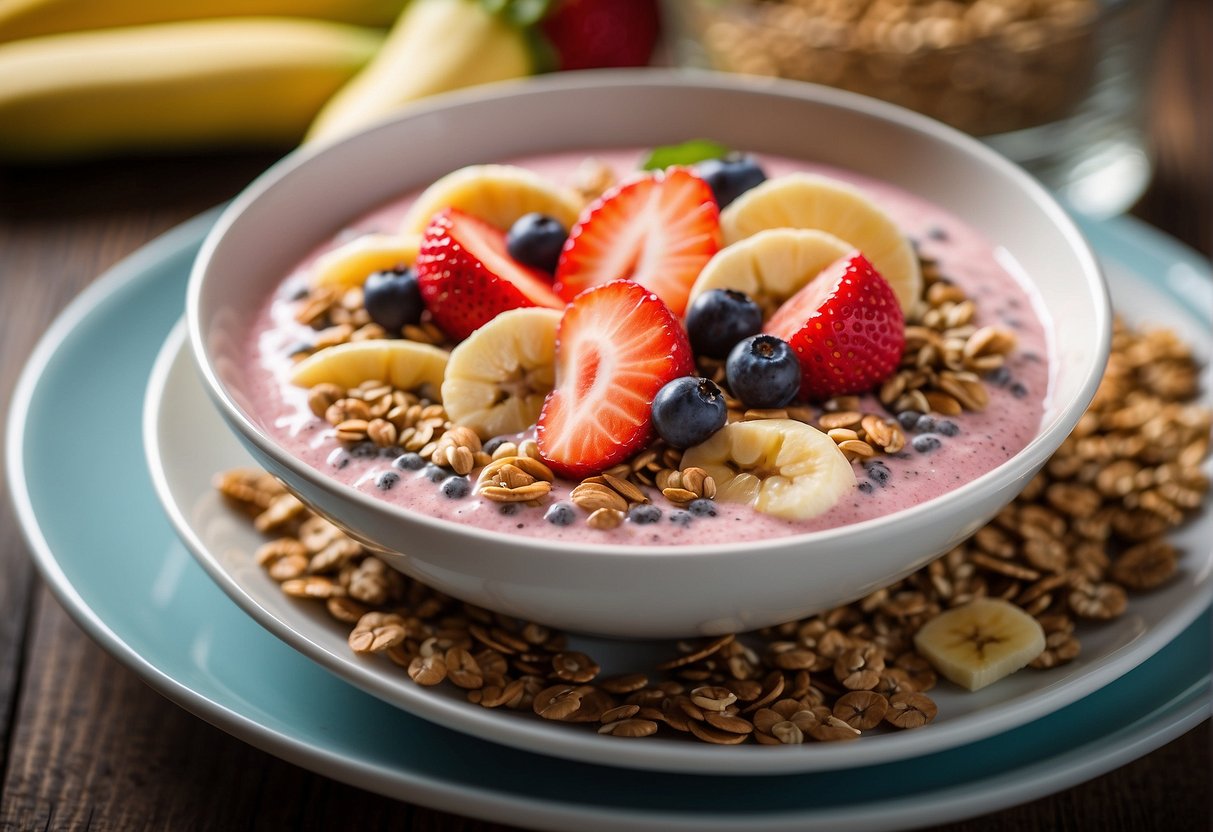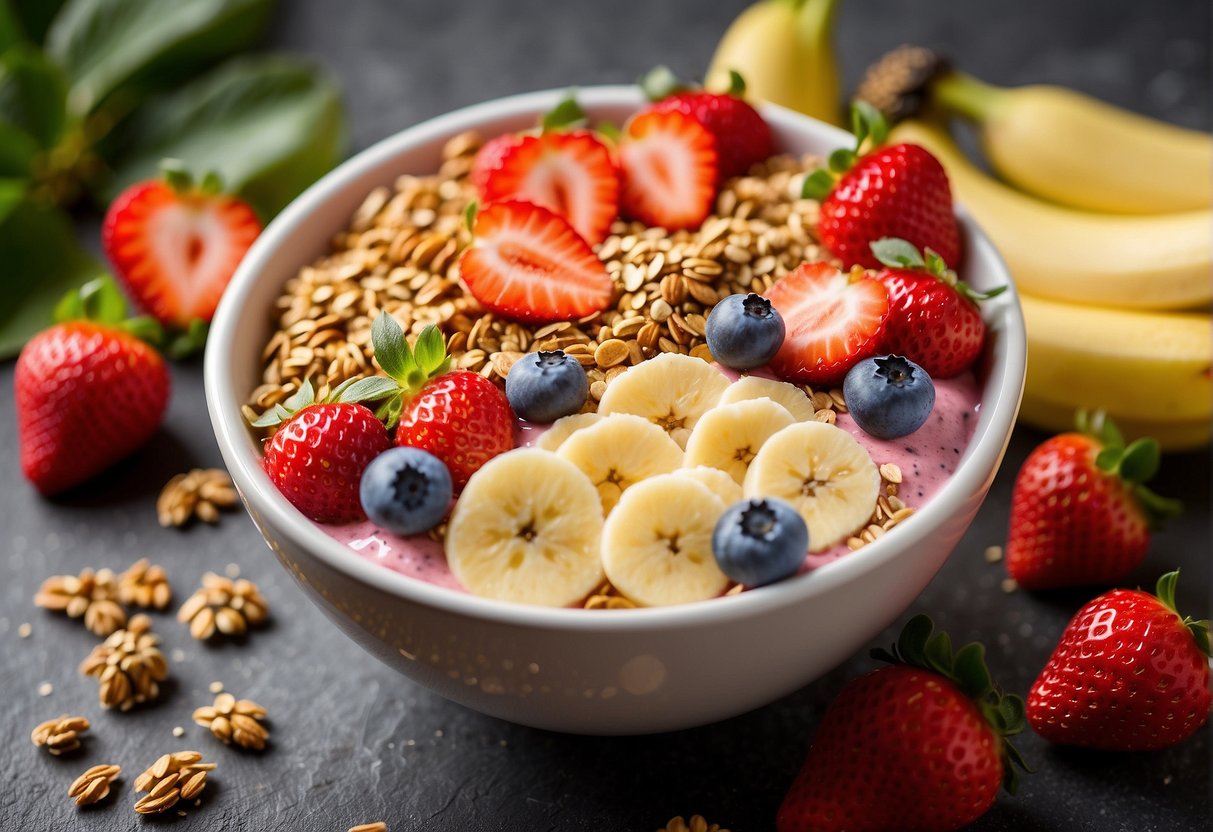Overview of Strawberry Banana Smoothie Bowls
I’m about to dive into why strawberry banana smoothie bowls are not just a delight to the eyes, but they’re also packing a punch when it comes to a nutritious breakfast option.
History and Popularity
My fascination with strawberry banana smoothie bowls began with their rise in popularity on social media. It’s no secret that they originated as a more filling version of traditional smoothies. Their visual appeal and customizable nature have earned them a spot as a top breakfast trend, blending the natural sweetness of strawberries and bananas with a variety of toppings.
Benefits of a Smoothie Bowl Breakfast
When I whip up a smoothie bowl for breakfast, I’m hitting more than just my taste buds. These bowls are a nutrient-dense option to start the day, providing a good balance of fiber, vitamins, and proteins—especially when I add a scoop of nut butter or a handful of seeds. Plus, they are incredibly filling, which helps in keeping my mid-morning snack cravings at bay.
Essential Ingredients

When I make my strawberry banana smoothie bowl, I focus on a blend of fresh flavors and textures. Getting the ingredients right is crucial for that perfect spoonable consistency and sweet, satisfying taste.
Fruits
For the fruit base, I always use frozen bananas to achieve a creamy texture, almost like soft serve. Frozen strawberries add a vibrant tanginess that balances the banana’s sweetness. Fresh fruit can serve as a refreshing topping, adding a burst of color and flavor to each bite.
Liquids
The liquid is key to bringing everything together without making it too runny. I typically go for a nut milk like almond or cashew milk because it’s creamy without being too heavy. However, if I want something a bit lighter, I’ll just add a splash of water.
Sweeteners
Bananas naturally sweeten the bowl, but sometimes I like a hint more sweetness. A drizzle of maple syrup can enhance the flavors, especially if the strawberries aren’t quite at peak ripeness.
Seeds and Nuts
For crunch and an extra nutritional punch, seeds and nuts are my go-tos. Chia seeds are fantastic, swelling up to create a tapioca-like texture while packing in fiber and omega-3s. As for nuts, I’ll sprinkle on some chopped almonds or walnuts for a satisfying chew and protein boost.
Nutritional Breakdown

Before you dig into your vibrant strawberry banana smoothie bowl, let me break down what’s going inside your body with each spoonful. These bowls are more than just delicious; they’re nutrient powerhouses.
Macronutrients
- Calories: Generally, a serving of strawberry banana smoothie bowl has about 200-300 calories, depending on the ingredients and serving size.
- Carbohydrates: Carbs are primarily provided by the fruit and any added sweeteners. You’re looking at around 45-60 grams per bowl.
- Fiber: Thanks to the strawberries and bananas, you get a good dose of fiber, about 7 grams, which helps with digestion.
- Protein: It’s not naturally high in protein; however, if I add Greek yogurt or a scoop of protein powder, it can bump up the amount significantly, often around 10-20 grams.
- Fat: It’s relatively low in fat unless you add ingredients like nuts or a drizzle of nut butter. Typically, the fat content can range from 2 to 15 grams.
Vitamins and Minerals
- Vitamin C: Strawberries are a powerhouse for Vitamin C. A smoothie bowl can cover well over 100% of my daily requirement.
- Potassium: Bananas are renowned for their potassium content, promoting heart health and electrolyte balance. A single bowl can provide around 500-700 mg.
- Vitamin A: If I add toppings like mango or incorporate greens like spinach, the Vitamin A content increases, which is great for my eyesight and immune system.
- Calcium: If I use fortified plant-based milk or dairy milk, each bowl can be a good calcium source, with roughly 10-20% of the daily recommended intake.
- Iron: Generally low, but choosing fortified ingredients or adding seeds can boost the iron content somewhat.
- Sodium: Naturally low in sodium, smoothie bowls are a heart-healthy choice with usually less than 150mg per serving.
Preparing Your Smoothie Bowl

When I’m making a smoothie bowl, I focus on the blending equipment, achieving that perfect, scoopable texture, and how I’ll garnish my creation to make it as appealing as possible.
Choosing the Right Blender
For the smoothie bowl, I use a high-speed blender because it has the power to crush ice and frozen fruits quickly, without leaving any unblended chunks. I’ve experienced that blenders with at least a 1000-watt motor perform best for smoothie bowls. If you’re searching for one, the COOKTORIA recipe uses a food processor or blender, highlighting the importance of having the right tool for the job.
Creating the Perfect Consistency
I start with frozen strawberries and bananas for a firm texture similar to soft serve. The secret here is to be parsimonious with the liquid—usually milk or a milk alternative. Just enough to keep the blades moving but not too much that you end up with a drinkable smoothie. If you want some added thickness, oats can be a game-changer. Remember, if the blend is too thin, I add more frozen fruits; if it’s too thick, a splash more liquid does the trick. The goal is to get a mixture that’s thick enough to eat with a spoon. A guide by The Conscious Plant Kitchen advises a step-by-step blending process to ensure a smooth consistency.
Serving Suggestions
Lastly, serving is where I let my creativity shine. I scoop the thick smoothie into a bowl and top with fresh banana slices, a handful of chopped strawberries, and a sprinkle of muesli for crunch. I enjoy it immediately while it’s still chilled and thick. For a personalized touch, you can explore a variety of toppings like nuts, seeds, or a drizzle of honey. The serving size is important, and according to the preparation details at Seasonal Cravings, you can adjust based on personal preference or dietary needs.
Customizing Your Bowl

When I make a strawberry banana smoothie bowl, I love getting creative with it. It’s like a delicious canvas awaiting a burst of colors and flavors. Here’s how I like to mix it up with toppings and adapt it to fit different dietary needs.
Variety of Toppings
I always start with a thicker smoothie bowl as my base; this way, the toppings don’t sink. My go-to’s are:
- Fresh Fruit: Sliced bananas and fresh strawberries add a juicy freshness.
- Granola: A sprinkle of homemade granola adds a satisfying crunch.
- Seeds and Nuts: Hemp seeds and a dollop of peanut butter provide protein.
- Sweet Extras: A handful of chocolate chips and coconut flakes are perfect for a sweet touch.
Each topping not only adds flavor but also a range of textures that make every spoonful interesting.
Special Dietary Adaptations
Whether you’re vegan, gluten-free, or looking for dairy-free options, there’s room to adapt. Here’s what I do:
- Vegan: I opt for non-dairy yogurt or a splash of almond milk to maintain creaminess.
- Gluten-Free: I ensure my granola is gluten-free; oats are naturally gluten-free, but I check for cross-contamination.
- Dairy-Free: It’s easy—you can use any plant-based milk or yogurt instead of their dairy counterparts.
By substituting a few ingredients, anyone can enjoy a smoothie bowl tailored to their dietary preferences.
Additional Tips and Tricks

When I make my smoothie bowls, I’ve learned a couple of secrets to making them both naturally sweet and visually stunning. Here are my personal tips and tricks to elevate your smoothie bowl game.
Using Overripe Fruits for Natural Sweetness
I always reach for overripe bananas when I’m blending up an easy smoothie bowl. Not only do they add an irresistible creaminess, but they’re also naturally sweeter, meaning I don’t need to add extra sugar. It’s a healthy win-win!
Creating Instagram-Worthy Smoothie Bowls
For those eye-catching bowls that pop on my Instagram feed, I stick to a few simple tricks. I make sure to use a variety of colorful fruit, nuts, and seeds for the toppings—neatly arranged, of course. Then, I grab a spot with good natural light, snap a pic, and watch the likes roll in. It’s that easy, and it makes all the difference in presentation!
Common Variations and Recipes

My smoothie bowl game is always on point, and I love experimenting with new flavors and textures! Here’s how I mix things up with seasonal twists and kid-friendly combinations.
Seasonal Twists
When summer hits, I toss in frozen fruits like mango or peach for a truly refreshing bowl that reminds me of ice cream without the melt! Come fall, I’m all about adding a scoop of pumpkin seeds for a crunchy texture and a burst of nutrients. Yup, a smoothie bowl recipe that adapts to the seasons is my kind of year-round treat.
Kid-Friendly Combinations
For the little ones, I focus on thicker, spoonable textures—they seem to love it that way! Tossing in some frozen banana makes it naturally sweet and creamy. Plus, I sneak in fresh spinach for a sneaky spinach smoothie bowl; don’t worry, they won’t even know it’s there. And for those vegan kiddos, I swap regular milk with non-dairy milk to keep it plant-based and just as delicious.
Frequently Asked Questions

In this section, I’ll address some common inquiries about crafting the perfect strawberry banana smoothie bowl. Let’s dive straight into the nitty-gritty of making your smoothie bowl experience stellar.
What’s the trick to making a smoothie bowl extra thick and creamy?
To get that irresistibly thick and creamy texture, I use frozen bananas at their ripest. The freeze locks in their natural sweetness and gives the smoothie bowl a rich consistency. For an extra kick, a scoop of nut butter also does wonders.
Can I still whip up a tasty smoothie bowl without frozen fruit on hand?
Sure, you can make a delicious smoothie bowl with fresh fruit, but it might not be as thick. To compensate, toss in some ice cubes or frozen yogurt to give it that cold, creamy texture you’re craving.
Would adding Greek yogurt affect the taste and texture of my strawberry banana smoothie bowl?
Absolutely, Greek yogurt is a game-changer! It boosts the protein content while making the smoothie bowl even creamier. The tanginess also contrasts nicely with the sweetness of the fruit.
What are some healthy ingredients I can add to my strawberry banana smoothie bowl?
I like to sprinkle in chia seeds or flaxseed for a boost of omega-3 fatty acids. Sometimes, I’ll mix in a handful of spinach for added nutrients without altering the flavor too much.
How many calories are typically in a strawberry banana smoothie bowl?
The calorie count in a strawberry banana smoothie bowl can vary, but generally, they hover around 300 to 400 calories for a sizable serving. Keep in mind, the toppings you choose can significantly affect the total calorie content.
Could you suggest some creative toppings to jazz up my smoothie bowl at home?
Get creative! Top off your bowl with a drizzle of honey, a handful of granola, or even some dark chocolate shavings. Fresh berries or sliced kiwi can add a nice pop of color and texture.
